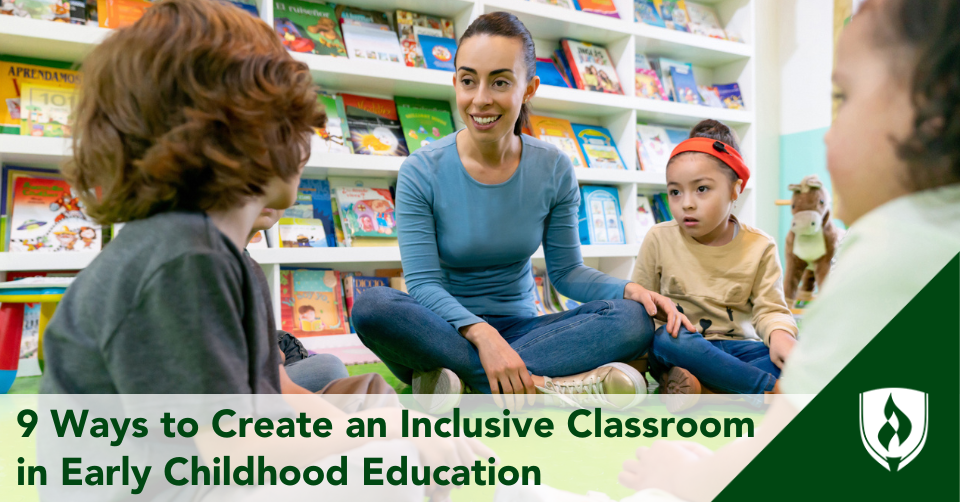The Importance of Teaching Tolerance: 9 Ways to Create an Inclusive Classroom
By Brianna Flavin on 12/21/2023

Creating inclusive classrooms can be challenging no matter what age group you are working with. But in early childhood education (ECE), it can feel especially tough. Toddlers and preschoolers internalize so much, so quickly.
These early years are the foundation of socialization that they will build on as they grow. And as they watch and learn about how people work or don’t work together, they gain another education entirely.
“Young children are very observant and not only pick up on differences, but also notice how we as adults attach value to differences,” says Dr. Kirstin Pesola McEachern, diversity and inclusion coordinator at The Summit Country Day School. Because of this, McEachern says it’s vital to help children learn how to appreciate diversity right from the start.
“Young students are more than our future; they are our now,” says Chad Dion Lassiter, professor of Race Relations at the University of Pennsylvania. Lassiter says schools have the opportunity to counteract racial socialization and learned biases that children pick up elsewhere.
But how?
An inclusive environment is so much more than adding an inspirational poster to the wall. If you want to prepare all the little ones in your care to pursue inclusivity, academic excellence and curiosity, the most important thing you can do is practice intentional teaching. We asked ECE experts to weigh in on how to make an inclusive learning environment in ECE.
First, what does an inclusive classroom environment look like?
When you picture inclusive classrooms, what do you imagine? Does the room offer images of children and families representing a wide array of differences? Do you create teaching strategies for how to incorporate different levels of student learning in your class?
You are only one person. To truly build an inclusive classroom environment, you have to consider multiple perspectives beyond your own.
Consider who your minority students might be (whoever that means in your environment). Are they represented in the books, pictures and materials you have in the room?
There are so many aspects of diversity to include. Racial, ethnic, gender, cultural and economic differences are all important to consider, as well as a wide array of family structures, LGBTQIA+ inclusion, neurodiversity and the range of differing physical ability students in your class may represent or encounter.
So, that’s a lot. But one type of teaching material can really hit many different goals at once. You guessed it—Books!
An inclusive classroom environment can look like so many different things, but one thing most inclusive classrooms will have in common is awesome and intentional reading material.
7 Powerful children's books for an inclusive ECE environment
“Books are truly the best way to teach different ways of thinking and to expose children to all types of topics they may not otherwise be exposed to,” says Dr. Teri DeLucca, founder & CEO of Impact Early Education.
Books can foster children’s sense of self-esteem, their understanding of differences and how to build friendships through easy-to-understand stories, DeLucca explains.
1. Mangos for Max1
“Almost every classroom in the United States has a child with life-threatening food allergies,” DeLucca says. Mangos for Max helps young children understand what food allergies are, and reading this book can help spread awareness of food allergies that could save lives.
As a monkey named Max goes through his day avoiding the bananas he is allergic to, children with food allergies can feel included while their peers gain understanding on how they can keep each other safe.
“The book shows how they can wash their hands after eating to not contaminate toys, and how they should not share food because it can make their friend Max very, very sick,” DeLucca says.
Why children like it
“I have personally read this book to many classrooms of preschoolers, and it is always so loved and enjoyed,” DeLucca says.
“Kids REALLY love the fun, silly pictures and the character Max-- they think he is so cool.”
In her classroom, DeLucca says the kids with food allergies felt so special, even proud to identify with the protagonist. “That is a very big deal for kids who feel so different and are often excluded.” Her preschoolers even asked their families to pack lunches that were safe for their friends with allergies so they could sit by them. “It was beautiful!”
2. Love Makes A Family2
This colorful book features different snippets of different families doing daily activities. The refrain “love is…” repeats throughout the book. Love is lending a helping hand. Love is reading one more book.
Many different family structures appear in each scene, allowing young ones to develop an awareness that every family is different—and love is the thing that binds them all together.
Why children like it
“These books resonate with my students because we all come from different backgrounds and these books teach them to love and accept their friends,” says Leslie Buch, leader of Latinx Montessori. “Since my classroom is very family-oriented, they enjoy books about family.”
Your young learners will likely see several activities they know from their own family lives, giving them even more context for the story.
3. We Don’t Eat Our Classmates3
This story is about a dinosaur who bites (a behavior any veteran ECE instructor will be familiar with.) “This isn’t a very DEI-centric book,” says Mary Muhs, Dean of Early Childhood Education at Rasmussen University. “But it is a good story about welcoming people who are a little different, especially those who might seem aggressive or less friendly.”
Since the dinosaur is often trying to make friends, Muhs says the story helps little learners understand that sometimes negative behaviors still come from a desire to play and fit in. “This is one book I recommend to everybody.”
Why children like it
“It’s funny!” Muhs laughs. “Children enjoy the humor behind it.” She explains that children love to laugh with each other and feed on each other’s laughter. And this book allows them to laugh while also giving the teacher plenty of things to talk about and ask them about while reading.
4. What if the Zebras Lost Their Stripes?4
“This is a fun book for preschoolers that includes rhyming to introduce issues of racial and ethnic diversity,” DeLucca says. This story explores Zebras who lose their stripes, some of them suddenly all black and some suddenly all white. Are they all still zebras inside?
“The book demonstrates the importance of showing compassion, kindness, and empathy towards diversity,” DeLucca says. “I have used this book in many classrooms and kids enjoy the pictures.”
Why children like it
“The preschoolers tend to get very quiet and listen intently when they see pictures of the black zebras and the white zebras after the zebras lost their stripes,” DeLucca says. She uses that moment to talk about how the only change the Zebras experienced was in how they looked.
“The book opens up some really great conversations about diversity. Kids really love the illustrations and the rhyming words—and they especially love the ending of the book.”
5. Just Ask!5
This book features a group of children who all navigate their day with differing abilities. One child has diabetes and shows how she takes her insulin shot. Children with ADHD and dyslexia explain how they work on projects. One child races other kids in a wheelchair and two classmates have autism, one who loves to talk and another who does not talk.
Importantly, each child explains how they manage their health and wellness in easy-to-understand terms, focusing on what they like and what they don’t like. Each page ends with a question for the preschoolers you read to.
Why children like it
The bright, clear explanations coming from each child in this story are very interesting to preschoolers who have likely already observed some of these things in the world around them.
It can be scary for children to talk about health issues or differing abilities—especially if someone they love has them, says Ashlie McEuen, curriculum content writer for Waterford. She’s been reading Caillou: Emma’s Extra Snacks6 with her daughter as a way to talk about diabetes.
“It opened the doors for her to ask more questions about my disease without having to reference me directly as she tends to get scared or nervous when discussing my health.”
Books like these, exploring illness or physical or neurological disabilities from children's eyes can encourage students to be curious instead of fearful.
6. Seven blind mice7
This iconic children’s story with its beautiful illustrations may have been on the shelves when you were a preschooler too! It features an Indian fable about six different brightly-colored mice who are blind. Each mouse interprets a different small part of the elephant they encounter.
“So many times, we just see little parts of us, we don’t see the whole picture of us,” Muhs says. “This story helps us think about how your outsides are just a part of who you are.”
Why children like it
The high-contrast illustrations with bright mice set against a black backdrop will draw the eye of even your youngest children. The book is short and simple, while also allowing kids the excitement of understanding what the mice are trying to figure out. “It’s an elephant! It’s an elephant!”
7. All Are Welcome8
This story follows a class of children wearing patkas, hijabs, yarmulkes and baseball caps. As the kids learn about each other’s traditions, they play and celebrate the fun and beautiful differences in their cultures.
Why children like it
Young learners really like the repetition of the words in this story, according to Diedra Boodoo, Professor in Rasmussen University's ECE program. “Children like the preschool setting, the interactions they witness, and the different colors that each child represents,” Boodoo says. “Children can really see themselves in those pictures.”
9 Strategies to create an inclusive classroom
Beyond the visuals, the reading material or any other element—an inclusive classroom environment really comes down to you.
Do you have a plan to model inclusive language to your students? How will you establish ground rules or classroom norms that support the diverse backgrounds you encounter?
How can you teach children a mutual respect for the other students in their diverse classroom? Children have so much natural curiosity about each other. As their educator, you have the opportunity to model respectful questions and interactions. Here's where to start...
1. Seek diversity in your own life
The heart of creating an inclusive learning environment is to also pursue inclusive learning in your own life. To understand what inclusion really means, you need to reach beyond your own perspective.
“In order for teachers to demonstrate respect and appreciation for differences, they need to first examine their own identities and how they contribute to a larger, diverse community,” McEachern says.
“We can preach the value of diversity, but if we do not surround ourselves with people different from us, ideas counter to ours, and experiences out of our comfort zones, we aren't modeling that for our students."
There are so many potential ways to do this, even if your time is limited. McEachern intentionally follows news sources and websites whose political affiliations are different from her own and reads books by authors from varied backgrounds.
2. Give your classroom a diversity 'audit'
Inclusivity is a learning process. Try to approach it with the fresh eyes of a new student.
McEachern advises teachers to complete “diversity audits” of their classrooms. This can be as simple as walking around your room and making note of the identities and cultures represented in your classroom materials, books, pictures and classroom décor. You could even invite a friend to come by and make a few observations about what they see.
It’s helpful to consider many different kinds of diversity as well. Perhaps you see a great representation of different ethnicities in your picture books for example, but don’t have any stories featuring various protagonists who are differently abled. If you walk around your class even for a moment in the mental shoes of someone else, you might notice a great deal.
3. Enhance your activities
Inclusivity can be part of everything you do in subtle ways. Whether you are helping the children experiment with paint colors or playacting, an inclusive mindset will show you plenty of ways to demonstrate inclusive behaviors as you talk to the children and interact.
Activities that encourage students to share about their families and their lives are also big parts of an inclusive classroom. When your young learners see you respect and honor their loved ones, their homes or their interests, they will feel more connected and welcome.
Trying out some specifically multi-cultural activities can also be a great way to open up conversations and have fun with the students. Check out 5 Multicultural Activities for Preschoolers to Help Teach the Importance of Diversity for more on that!
4. Be consistent in your expectations
“Have high expectations for all of your students,” Charesha Barrett of CHARP Education Consulting. Barrett says. Children can start internalizing messages about their ability or their value early on. If you start to expect less of certain students or seem inconsistent in the way you discipline, they will notice.
While every child needs something a little different in terms of teaching, your expectations of their performance and the way you handle class discipline should be consistent from child to child.
Ultimately, kids are very perceptive. Students feel your openness and curiosity just as much as they can feel intolerance or dismissive comments. Model appropriate behavior, respect and kindness in your class discussion about the books you read together, and watch the students learn from your example.
5. Honor special days
A quick Google search can tell you that many days out of the year are dedicated to something special. Some of these days might be important celebrations in specific cultures, and some are along the lines of “National Doughnut Day.” But Barrett says celebrating notable days each month for women, Native Americans and African-Americans can be a great way to introduce more inclusion into your classroom.
6. Be quick to listen
Nothing is quite as powerful as hearing other people’s stories. Many biases begin in assumption. So no matter how much experience you’ve had, letting people tell their stories and listening to them can show your students that everyone deserves respect. Lassiter says he spends plenty of time with people from different communities but constantly tries to expand those horizons.
Listening to your students and their families is a huge part of this process as well, according to Barrett. “Teachers can build a community of diversity by making their classrooms student-centered, in which each voice and emerging opinion is heard and respected,” Barrett says.
7. Know who you are
“It is imperative for me to have a strong understanding of self,” Barrett says. “’Who am I? How does my upbringing play a major role in the person that I am today?’ In order to measure my competency in inclusivity, I have to understand emotional intelligence.” Barrett says emotional intelligence is a major factor in responding with or without tolerance when confronted with a different culture.
When you are strong in your own identity and able to empathize with others, you will be better able to navigate differences.
8. Ask questions during story time
If you have some amazing stories to read aloud to the children, enhance the whole experience by engaging with them as you read.
“Remember, story time should not be silent!” DeLucca says. “Pause and ask the children questions, point out key messages, and guide their understanding of the story progression during read-alouds.” This makes the story come alive to them.
Questions like "Why did he say that?" or "How do you think the monkey is feeling?" can help children develop empathy and social awareness as they listen to the story.
9. Commit to your own ongoing education
There is always more to discover about people and the ways in which we are diverse. Barrett works to develop more skill in empathy, appreciation and listening without judgment. “Once I am aware and know about different cultures, then I develop the right attitude and skills to manage cross-cultural relationships. Throughout the year, I participate in diversity and inclusion workshops and cultural events.”
Lassiter says diversity and anti-racism training should be a part of education for teachers. If your school doesn’t offer training in this important subject, they might be willing to sponsor your attendance at a local conference.
If not, the Teaching Tolerance website offers lots of resources for teachers who want to expand their understanding of inclusivity. “The resources there are free, including webinars on particular topics if teachers need to build capacity in a certain area,” McEachern says.
The importance of inclusivity in ECE and the importance of you
As you can see, creating an inclusive environment takes a lot of intention and effort. But it's worth it. As more research in child development shows, the first six years in a child's life have massive impacts on how their brain forms, rippling through academics, social life and even health outcomes.9
A huge part of an inclusive classroom is you, the teacher. Your attitude toward others and how you embrace or include differences will impact your students more than you know. And you bring your own heritage, community and cultural demographics into representation as well when you let your young learners see who you are. It's beautiful.
Giving children (and future generations) the best possible foundation to build their lives on impacts the world in SO many ways. Would you like to hear more? Check out 5 Reasons the Importance of Early Childhood Education Is Impossible to Ignore for more detail on why these early years can change everything.
Check out our other article, "Early Childhood Mental Health: 8 Things ECE Professionals Should Know".
Rasmussen University ECE programs do not prepare students for licensed teaching positions in any public school setting, but students will have the opportunity to help shape the futures of young children from birth to age six in a childcare and non-public school setting or leadership role.
1Dr. Jessica St. Louis, Mangos for Max, September 6, 2013
2Sophie Beer, Love Makes a Family, May, 2018
3Ryan T. Higgins, We Don’t Eat Our Classmates, June 19, 2018
4John Reitano, What If the Zebras Lost Their Stripes?, September 1, 1998
5Sonia Sotomayor, Just Ask!: Be Different, Be Brave, Be You, September 3, 2019
6Anne Paradis, Caillou: Emma’s Extra Snacks: Living with Diabetes (Playtime), September 29, 2015
7Ed Young, Seven Blind Mice, April 29, 1992
8Alexandra Penfold (Author), Suzanne Kaufman (Illustrator), All Are Welcome, July 10, 2018
9Allen LR, Kelly BB, editors. Transforming the Workforce for Children Birth Through Age 8: A Unifying Foundation. National Academies Press (2015) National Bureau of Economic Research, Schools, Skills and Synapses [accessed December 2023]https://www.nber.org/papers/w14064.




